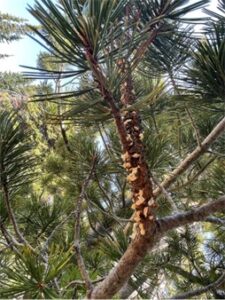
Scientists Sequence Genome for Threatened Whitebark Pine
Whitebark pine at sunset in the northern Carson Range of the Sierra Nevada. Image credit: Quinn Lowrey.
Media Contacts:
Julee Shamhart — [email protected] — (406) 925-9545
Kat Kerlin — [email protected] — (530) 750-9195
FOR IMMEDIATE RELEASE
Scientists Sequence Genome for Threatened Whitebark Pine
Paving the Way for Genomic Insights into Whitebark Pine Restoration
MISSOULA, Mont. (Dec. 13, 2023) – Researchers have sequenced the whitebark pine genome, presenting new opportunities to help the threatened, high-altitude tree endure environmental challenges.
“Sequencing the whitebark pine reference genome is an important scientific contribution,” said project lead David Neale, professor emeritus in the Plant Sciences department at the University
of California, Davis. “It is the first step in creating genomic tools that can rapidly screen trees for disease resistance and climate adaptation. With this information, researchers can expedite the supply of resistant seedlings for cost-effective restoration.”
The sequence is now accessible at TreeGenes, a Forest Tree Genome Database. A pre-print version of the scientific paper is available on bioRxiv, and it is undergoing the peer-review process.
Keystone Whitebark Pine in Decline

White pine blister rust aeciospores erupt from a canker caused by the nonnative fungus, Cronartium ribicola. The canker will kill the underlying bark on this branch and prevent nutrients from reaching the branch above the canker. Image Credit: National Park Service.
In January 2023, the U.S. Fish & Wildlife Service listed whitebark pine as threatened under the U.S. Endangered Species Act after more than 325 million whitebark pine died due to a variety of factors. These threats include the introduced fungal pathogen white pine blister rust, mountain pine beetle outbreaks, wildfire and climate change.
The decline of whitebark pine is of concern given its role as a keystone species across its 80.6 million-acre range in the western U.S. and Canada. Found up to the tree lines of Western mountains, whitebark pine is particularly imperiled in the Rocky Mountains, Pacific Northwest and northern Sierra Nevada.
These trees protect snowpack that helps prolong streamflow, supply critical food resources for grizzly bears and red squirrels, and provide cultural value to Indigenous communities through its spiritual significance as a resilient tree species. Whitebark pine also shares a special mutualistic relationship with the Clark’s nutcracker, the primary distributor of whitebark pine seeds.
25,000 Genes Isolated from Oregon Tree
Sequencing conifer genomes can be challenging because they are three to 10 times larger than the human genome. To date, the genomes of loblolly pine, Douglas fir, sugar pine, coastal redwood, giant sequoia, and now, whitebark pine, have all been sequenced. The Whitebark Pine Genome Project used genetic material from a 150-year-old tree from the Deschutes National Forest near Bend, Ore., to isolate and sequence the DNA.
Researchers identified 25,362 genes and mapped 87% of the genetic material within the whitebark pine’s 12 pair chromosomes. These genomic findings can enhance scientists’ understanding of natural genetic resilience to blister rust, bark beetle outbreaks, drought and other climate extremes.
New Restoration Opportunities
Clark’s nutcracker caching a whitebark pine seed. Image Credit: Jackson Chase.
With the whitebark pine genome sequencing completed, forest managers are now one step closer to developing cost-effective genomic screening tools that identify genetic traits important for whitebark pine survival.
Previous methods involved identifying rust-resistant trees, collecting their cones, growing seedlings in a greenhouse for two years, conducting rust-resistance screenings on the seedlings for three years, and monitoring seedlings for up to an additional five to 10 years before planting in the field. This process costs about $1,200-$1,800 per tree.
Genome sequencing offers a faster, more efficient approach that could reduce costs to as little as $100 per tree and time to a matter of weeks. That is because only small amounts of needle tissue are needed to identify genes responsible for resistance to environmental threats.
The next steps include securing funding to investigate how different environmental conditions are linked to genetic variations within whitebark pine populations.
“Sequencing just one tree, as we did for the reference genome, is not enough,” Neale said. “We need to understand the genetic variation of whitebark pine to develop future genomic tools for rapid screenings and inform restoration efforts of this iconic species. We’d like to test many trees with varying resistance levels and relate this genetic diversity with the genes responsible for resistance.”
The research was done in collaboration with UC Davis, the Whitebark Pine Ecosystem Foundation, Johns Hopkins University and University of Connecticut.
Funding was provided by the USDA Forest Service Forest Health Protection, American Forests, and the Krieger Charitable Trust.
More information for the media and photo resources are available online in a media kit. A PDF version of this press release is also available for download.
About the Whitebark Pine Ecosystem Foundation
The Whitebark Pine Ecosystem Foundation is a nonprofit based in Missoula, Mont., that promotes the conservation and restoration of whitebark pine and other high-elevation, five-needle white pines through education and outreach, research, and collaborations. More information about whitebark pine and the foundation can be found at whitebarkfound.org.

